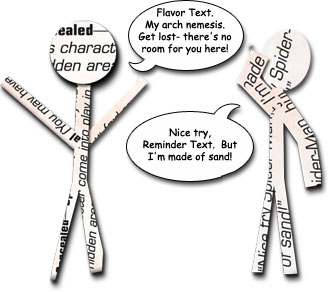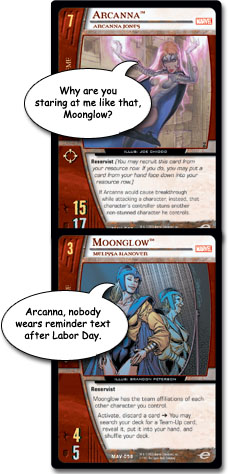
One thing players might have noticed starting with the Marvel Knights expansion was that R&D began to include reminder text on cards that featured a new keyword mechanic. "Concealed (This character comes into play in the hidden area.)" was our first reminder text. We would later expand the frequency of reminder text by continuing to use it on keyword cards and by creating it for older keywords that were being re-featured in the newer sets.
Let’s review some of the pros and potential cons of using reminder text on cards. Perhaps the most important benefit of reminder text is to give players who are new to the game or to the expansion access to an immediate reminder of how the keyword mechanic works. This helps to avoid potential confusion and saves the player the time of having to look up the related rules.
You’ll note that we typically avoid using keywords on starter deck cards. We want to keep those cards as basic as possible for our entry-level players so that they can focus on learning game engine mechanics like recruiting, formations, and attacking. In turn, the rulebooks that come with the starters focus on explaining and reinforcing these basic game principles. Since keywords don’t appear on the starter cards, the rules for these keywords don’t appear in the starter rulebooks. When new players make the jump from starters to boosters, reminder text quickly allows them to learn new mechanics that don’t appear in the starter decks.
Since we are reviewing both pros and cons in this article, a fair question to ask is, “Why not just include the rules for the keywords at the end of the starter rulebook?” I think I can safely claim that, in general, people don’t like to spend time reading rulebooks. They want to play as soon as they can pull a game out of its packaging. The faster they can get through a rulebook, the faster they can start playing. There are, of course, exceptions to this rule, but did you honestly read through the booklet that came with your stereo, I-Pod, or PS-2 before you started using it? Have you ever noticed how many computer games start with an in-game tutorial instead of relying on players to read a rulebook to learn how to play? Many people won’t even open a rulebook unless there’s something they don’t understand once they start playing. Reminder text can help prevent this from happening.
 So, when should a card have reminder text? Sometimes the length of the game text on a card doesn’t allow for reminder text. In those cases, the game text takes priority over the reminder text. It’s hard to reminder text a mechanic if you have to pull the mechanic to make room for the reminder text. What about flavor text? The answer isn’t as clear in this situation. In a vacuum, it would be safe to say that understanding how to play the game is more important for a player than learning comic lore about the character. However, cards don’t exist in a vacuum; they typically appear in a set with 219 other cards. If every other card in the set with the same keyword has reminder text, how important is it for the last card to have the same reminder text? What if twenty cards have to lose flavor to make room for reminder text? If you worked in R&D, would you create a standardized policy for reminder and flavor text, or would you make your decision on a card-by-card basis?
So, when should a card have reminder text? Sometimes the length of the game text on a card doesn’t allow for reminder text. In those cases, the game text takes priority over the reminder text. It’s hard to reminder text a mechanic if you have to pull the mechanic to make room for the reminder text. What about flavor text? The answer isn’t as clear in this situation. In a vacuum, it would be safe to say that understanding how to play the game is more important for a player than learning comic lore about the character. However, cards don’t exist in a vacuum; they typically appear in a set with 219 other cards. If every other card in the set with the same keyword has reminder text, how important is it for the last card to have the same reminder text? What if twenty cards have to lose flavor to make room for reminder text? If you worked in R&D, would you create a standardized policy for reminder and flavor text, or would you make your decision on a card-by-card basis?
Continuing along these lines, what is the relative value of reminder text to a player after he or she has learned the new keyword mechanic? There’s going to be a certain percentage of players that learn the keyword directly off the rules insert two minutes after opening the box. For them, reminder text is just extra words on the cards. As a counter argument, it may be fair to say that the reminder text still holds value if these players are playing against an opponent who would find the reminder text useful. Another realization is that reminder text, for all players, becomes meaningless at some point. After playing with the cards in repeated games, players eventually gain a complete understanding of the new mechanic, and reminder text once again becomes extra words on the cards.
 If you examine the last few sets, you’ll see that not every card with a keyword has reminder text. There are a good number of cards that have short enough game and flavor text to have room for reminder text, but don’t have it. If you look very closely, you’ll discover that the majority of those cards are uncommon and rare. So, why do we put the majority of reminder text on common cards? Simple—if a player only has access to a few packs of cards or participates in a Sealed or Draft tournament when the set first releases, that player will see more common than uncommon or rare cards.
If you examine the last few sets, you’ll see that not every card with a keyword has reminder text. There are a good number of cards that have short enough game and flavor text to have room for reminder text, but don’t have it. If you look very closely, you’ll discover that the majority of those cards are uncommon and rare. So, why do we put the majority of reminder text on common cards? Simple—if a player only has access to a few packs of cards or participates in a Sealed or Draft tournament when the set first releases, that player will see more common than uncommon or rare cards.
This allows R&D to take the middle ground by putting reminder text on cards that appear frequently during play without over-saturating every keyword card in the set with reminder text. I should mention that there are advocates within R&D who, as a general policy, want to put reminder text on all keyword cards. They cite the following supporting points. A certain percentage of players, due in part to the placement and font used for reminder text, find it an invisible element of the card text. These players recognize reminder text for what it is and can easily ignore it. Also, players can’t control which cards they will have access to at any given point in the game. What if R&D chose not to reminder text one card due to flavor text issues, and that ended up being the only keyword card in a new player’s hand during a Sneak Peek event?
As you can see, there are no easy answers, and R&D will continue to listen to our players to discover what they find most helpful and least distracting. What do you think? Danny Mandel believes R&D should put reminder text on every new keyword card whenever the game text length allows for it. Do you agree with him? Do you disagree with him? Let him know at dmandel@metagame.com.